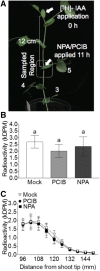Initial Bud Outgrowth Occurs Independent of Auxin Flow from Out of Buds
- PMID: 30404820
- PMCID: PMC6324225
- DOI: 10.1104/pp.18.00519
Initial Bud Outgrowth Occurs Independent of Auxin Flow from Out of Buds
Abstract
Apical dominance is the process whereby the shoot tip inhibits the growth of axillary buds along the stem. It has been proposed that the shoot tip, which is the predominant source of the plant hormone auxin, prevents bud outgrowth by suppressing auxin canalization and export from axillary buds into the main stem. In this theory, auxin flow out of axillary buds is a prerequisite for bud outgrowth, and buds are triggered to grow by an enhanced proportional flow of auxin from the buds. A major challenge of directly testing this model is in being able to create a bud- or stem-specific change in auxin transport. Here we evaluate the relationship between specific changes in auxin efflux from axillary buds and bud outgrowth after shoot tip removal (decapitation) in the pea (Pisum sativum). The auxin transport inhibitor 1-N-naphthylphthalamic acid (NPA) and to a lesser extent, the auxin perception inhibitor p-chlorophenoxyisobutyric acid (PCIB), effectively blocked auxin efflux from axillary buds of intact and decapitated plants without affecting auxin flow in the main stem. Gene expression analyses indicate that NPA and PCIB regulate auxin-inducible, and biosynthesis and transport genes, in axillary buds within 3 h after application. These inhibitors had no effect on initial bud outgrowth after decapitation or cytokinin (benzyladenine; BA) treatment. Inhibitory effects of PCIB and NPA on axillary bud outgrowth only became apparent from 48 h after treatment. These findings demonstrate that the initiation of decapitation- and cytokinin-induced axillary bud outgrowth is independent of auxin canalization and export from the bud.
© 2019 American Society of Plant Biologists. All Rights Reserved.
Figures






Similar articles
-
Boron controls apical dominance in Pea (Pisum sativum) via promoting polar auxin transport.Physiol Plant. 2025 Jan-Feb;177(1):e70056. doi: 10.1111/ppl.70056. Physiol Plant. 2025. PMID: 39815973
-
Strigolactone Inhibition of Branching Independent of Polar Auxin Transport.Plant Physiol. 2015 Aug;168(4):1820-9. doi: 10.1104/pp.15.00014. Epub 2015 Jun 25. Plant Physiol. 2015. PMID: 26111543 Free PMC article.
-
Strigolactone acts downstream of auxin to regulate bud outgrowth in pea and Arabidopsis.Plant Physiol. 2009 May;150(1):482-93. doi: 10.1104/pp.108.134783. Epub 2009 Mar 25. Plant Physiol. 2009. PMID: 19321710 Free PMC article.
-
Auxin-cytokinin interactions in the control of shoot branching.Plant Mol Biol. 2009 Mar;69(4):429-35. doi: 10.1007/s11103-008-9416-3. Epub 2008 Oct 30. Plant Mol Biol. 2009. PMID: 18974937 Review.
-
Ready, steady, go! A sugar hit starts the race to shoot branching.Curr Opin Plant Biol. 2015 Jun;25:39-45. doi: 10.1016/j.pbi.2015.04.004. Epub 2015 May 15. Curr Opin Plant Biol. 2015. PMID: 25938609 Review.
Cited by
-
Plant Development in the Garden Pea as Revealed by Mutations in the Crd/PsYUC1 Gene.Genes (Basel). 2023 Nov 23;14(12):2115. doi: 10.3390/genes14122115. Genes (Basel). 2023. PMID: 38136938 Free PMC article.
-
Integrative proteome and metabolome unveil the central role of IAA alteration in axillary bud development following topping in tobacco.Sci Rep. 2024 Jul 3;14(1):15309. doi: 10.1038/s41598-024-66136-4. Sci Rep. 2024. PMID: 38961197 Free PMC article.
-
Plasticity of bud outgrowth varies at cauline and rosette nodes in Arabidopsis thaliana.Plant Physiol. 2022 Mar 4;188(3):1586-1603. doi: 10.1093/plphys/kiab586. Plant Physiol. 2022. PMID: 34919723 Free PMC article.
-
I am all ears: Maximize maize doubled haploid success by promoting axillary branch elongation.Plant Direct. 2020 May 15;4(5):e00226. doi: 10.1002/pld3.226. eCollection 2020 May. Plant Direct. 2020. PMID: 32426692 Free PMC article.
-
The bud awakens: Interplay among hormones and sugar controls bud release.Plant Physiol. 2023 May 31;192(2):703-704. doi: 10.1093/plphys/kiad165. Plant Physiol. 2023. PMID: 36943298 Free PMC article. No abstract available.
References
-
- Alam MM, Hammer GL, van Oosterom EJ, Cruickshank AW, Hunt CH, Jordan DR (2014) A physiological framework to explain genetic and environmental regulation of tillering in sorghum. New Phytol 203: 155–167 - PubMed
-
- Balla J, Blazkova J, Reinohl V, Prochazka S (2002) Involvement of auxin and cytokinins in initiation of growth of isolated pea buds. Plant Growth Regul 38: 149–156
-
- Balla J, Kalousek P, Reinöhl V, Friml J, Procházka S (2011) Competitive canalization of PIN-dependent auxin flow from axillary buds controls pea bud outgrowth. Plant J 65: 571–577 - PubMed
Publication types
MeSH terms
Substances
LinkOut - more resources
Full Text Sources
Other Literature Sources

